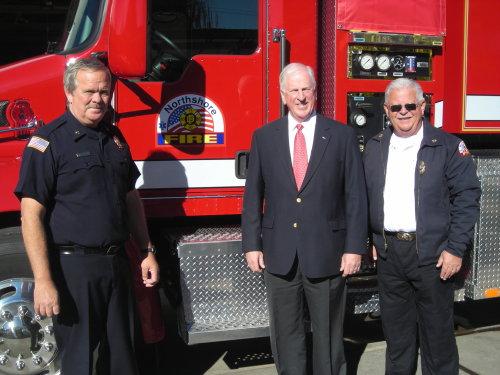WASHINGTON, DC – The nationwide unemployment rate showed a slight improvement in November, with jobs lost in the month down significantly, according to a Friday report.
The US Bureau of Labor Statistics reported that the US unemployment rate was 10 percent, down from 10.2 percent in October. In November 15.4 million Americans were out of work.
The California Employment Development Department's most recent report – issued late last month – reported the state's unemployment at 12.5 percent in October. Lake County's unemployment for that month was 16.2 percent, as Lake County News has reported.
While a minor improvement, the 10 percent national unemployment rate still accounts for the second-highest unemployment rate of the year, according to US Bureau of Labor Statistics records.
At the start of the recession in December 2007, the number of unemployed persons was 7.5 million, and the jobless rate was 4.9 percent. In December 2008, the rate was 7.2.
The rate has grown steadily throughout 2009, beginning at 7.6 percent in January and edging upward on a monthly basis.
There was a brief exception to that trend, in May, June and July, when unemployment rates were 9.4, 9.5 and 9.4 percent, respectively, showing a minor rollback before the rate climbed to 9.7 in in August.
Perhaps the most encouraging part of the report came in job loss numbers.
Federal officials reported that nonfarm payroll employment was essentially unchanged since October, with a loss of 11,000 jobs.
The agency noted that, in the prior three months, payroll job losses had averaged 135,000 a month. In November, employment fell in construction, manufacturing, and information, while temporary help services and health care added jobs.
Among the major worker groups, unemployment rates for adult men (10.5 percent), adult women (7.9 percent), teenagers (26.7 percent), whites (9.3 percent), blacks (15.6 percent) and Hispanics (12.7 percent) showed little change in November. The unemployment rate for Asians was 7.3 percent, not
seasonally adjusted.
Among the unemployed, the number of job losers and persons who completed temporary jobs fell by 463,000 in November. The number of long-term unemployed (those jobless for 27 weeks and over) rose by 293,000 to 5.9 million. The percentage of unemployed persons jobless for 27 weeks or more increased by 2.7 percentage points to 38.3 percent.
The civilian labor force participation rate was little changed in November at 65.0 percent. The employment-population ratio was unchanged at 58.5 percent.
The number of people working part time for economic reasons (sometimes referred to as involuntary part-time workers) was little changed in November at 9.2 million. These individuals were working part time because their hours had been cut back or because they were unable to find a full-time job.
About 2.3 million persons were marginally attached to the labor force in November, an increase of 376,000 from a year earlier. (The data are not seasonally adjusted.) These individuals were not in the labor force, wanted and were available for work, and had looked for a job sometime in the prior 12
months. They were not counted as unemployed because they had not searched for work in the 4 weeks preceding the survey.
Among the marginally attached, there were 861,000 discouraged workers in November, up from 608,000 a year earlier. (The data are not seasonally adjusted.) Discouraged workers are persons not currently looking for work because they believe no jobs are available for them. The remaining 1.5 mil-
lion persons marginally attached to the labor force had not searched for work in the 4 weeks preceding the survey for reasons such as school attendance or family responsibilities.
Total nonfarm payroll employment was essentially unchanged in November (-11,000). Job losses in the construction, manufacturing, and information industries were offset by job gains in temporary help services and health care. Since the recession began, payroll employment has decreased by 7.2
million.
Construction employment declined by 27,000 over the month. Job losses had averaged 117,000 per month during the 6 months ending in April and 63,000 per month from May through October. In November, construction job losses were concentrated among nonresidential specialty trade contractors
(-29,000).
Manufacturing employment fell by 41,000 in November. The average monthly decline for the past 5 months (-46,000) was much lower than the average monthly job loss for the first half of this year (-171,000). About 2.1 million manufacturing jobs have been lost since December 2007; the majority of
this decline has occurred in durable goods manufacturing (-1.6 million).
Employment in the information industry fell by 17,000 in November. About half of the job loss occurred in its telecommunications component (-9,000).
There was little change in wholesale and retail trade employment in November. Within retail trade, department stores added 8,000 jobs over the month.
The number of jobs in transportation and warehousing, financial activities, and leisure and hospitality showed little change over the month.
Employment in professional and business services rose by 86,000 in November. Temporary help services accounted for the majority of the increase, adding 52,000 jobs. Since July, temporary help services employment has risen by 117,000.
Health care employment continued to rise in November (21,000), with notable gains in home health care services (7,000) and hospitals (7,000). The health care industry has added 613,000 jobs since the recession began in December 2007.
In November, the average workweek for production and nonsupervisory workers on private nonfarm payrolls rose by 0.2 hour to 33.2 hours. The manufacturing workweek increased by 0.3 hour to 40.4 hours. Factory overtime rose by 0.1 hour to 3.4 hours. Since May, the manufacturing workweek has increased by 1.0 hour.
In November, average hourly earnings of production and nonsupervisory workers on private nonfarm payrolls edged up by 1 cent, or 0.1 percent, to $18.74. Over the past 12 months, average hourly earnings have risen by 2.2 percent, while average weekly earnings have risen by 1.6 percent.
The change in total nonfarm payroll employment for September was revised from a loss of 219,000 to a loss of 139,000, and the change for October was revised from 190,000 jobs lost to 111,000 jobs lost.
Follow Lake County News on Twitter at http://twitter.com/LakeCoNews and on Facebook at http://www.facebook.com/pages/Lake-County-News/143156775604?ref=mf .











